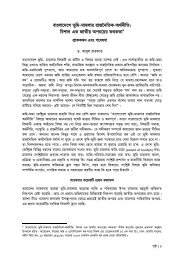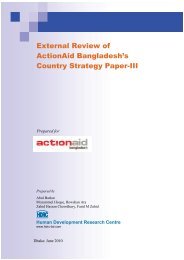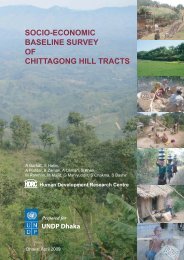08. Costing Essential Services Package An Issue Paper
08. Costing Essential Services Package An Issue Paper
08. Costing Essential Services Package An Issue Paper
Create successful ePaper yourself
Turn your PDF publications into a flip-book with our unique Google optimized e-Paper software.
<strong>Costing</strong> <strong>Essential</strong> <strong>Services</strong> <strong>Package</strong>: <strong>An</strong> <strong>Issue</strong> <strong>Paper</strong> 15<br />
commodities were worked out by levels of service and by interventions within each sub-program<br />
area of ESP. The input-wise costing for the first year for ESP, and all other log frame activities<br />
and outputs have been worked out.<br />
The costs of ESP interventions for the second through fifth year have been estimated using the<br />
costs in year-1 as the base costs, and assuming that the cost of manpower will increase by 10<br />
percent in the second and the third year and will then remain constant onward in nominal terms,<br />
while the commodity cost will continue to increase by 10 percent per annum.<br />
The Review Group (RG) which costed ESP interventions also estimated the cost of each ESP<br />
component by inputs, by type of fund and by cost centres, for only year-1. In estimating costs<br />
by inputs, the RGs followed the input classification as shown in the RIBEC Model 6> so as to<br />
facilitate comparison of costs by inputs as estimated for the health sector with the same for the<br />
other sectors in Bangladesh. In classifying expenditures by type of funding, only two types of<br />
budget were considered --- non-development (revenue) budget and development budget. The<br />
classification was considered useful to determine the quantum of foreign assistance required for<br />
HPSP. The estimation of expenditures by cost centres was done to help allocation of funds<br />
among the cost centres and monitoring of ESP activities.<br />
As reported in the HPSP document, after the Pre-Appraisal Mission, Task Forces were<br />
requested to revisit the costs of other HPSP interventions, and estimate the costs by inputs, by<br />
type of funds, and by cost-centres for year-1. In estimating total costs of each intervention for<br />
the whole plan period, the TFs more or less used similar formula for costing manpower and<br />
commodities. However, the cost of repair and maintenance for the interventions that involve<br />
considerable amount of expenditures for facility development was assumed to be increasing at<br />
the compound rate of 10 percent per annum. The costs of other inputs for each year after year-<br />
1 were notionally determined for each outcome (GoB 1998a: 75).<br />
During the appraisal mission it was suggested that in view of the large gap between the<br />
estimate of expenditure obtained using the bottom-up method and the realistic estimate of the<br />
resource envelope, the expenditure has to be reduced based on an appropriate priority<br />
exercise. Accordingly, the estimate of expenditure was adjusted to the amount of resources<br />
allocated to each specific item imposing a budget constraint on the expenditure. The<br />
reconciliation between the bottom-up and the top-down estimates of expenditure was brought<br />
about by reducing the magnitude of program activities in terms of coverage and the amount of<br />
services to be delivered per person.<br />
The PPC’s ESP costing (expenditure estimation) methodology and procedural steps suffer from<br />
some inadequacies, some of which are already indicated in the HPSP document itself (GoB<br />
1998a). Some of the pertinent issues have already been dealt with by Tim Ensor (1999). Based<br />
on our analysis of the PPC’s ESP <strong>Costing</strong>, it would be pertinent to raise the following issues<br />
which deserve due attention to arrive at a close to perfect costing in the future:<br />
6> RIBEC (Reforms in Budgeting and Expenditure Control) model comprises of inputs by sources of funds. The<br />
sources are government and development partners divided further by RPA (reimbursable project aid) and DPA<br />
(direct project aid including commodity aid). The inputs are divided into recurrent and capital, and revenue and<br />
development. The elements of recurrent inputs include pay of officers, staff, allowances, MSR (excluding drugs),<br />
drugs (excluding surgical requisite), other supplies, repair and maintenance, training (local and overseas),<br />
other/printing forms; capital inputs include construction (land and construction), vehicle, furniture, equipment, TA,<br />
training, services/research/pilot, others/printing.






